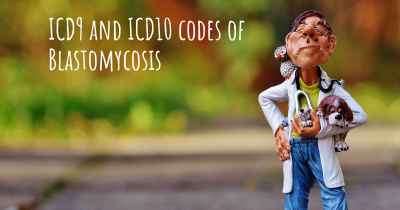17
What is the history of Blastomycosis?
When was Blastomycosis discovered? What is the story of this discovery? Was it coincidence or not?

Disease Name
· Blastomycosis
· North American Blastomycosis
· Gilchrist’s Disease
· Chicago Disease
History
Blastomycosis was discovered by a French botanist/biologist named Philippe Edouard Léon Van Tieghem in 1876. Blastomycosis is often called Gilchrist’s Disease because it was first described by Thomas Caspar Gilchrist who initially named it b. dermatitidis thinking that it was primarily a dermatological disease. Although further studies showed that the pulmonary system was the first organ system to be affected (1).
Etiological Agents
Blastomyces dermatitidis, the asexual state of Ajellomyces dermatitidis, which is one of the two serotypes (5).
Reservoirs
Moist soil that has decomposing organic debris. You would find these type of soils mostly in south central, south eastern and mid western United states. Microfoci can also be found in Central and South America, and Africa (4).
Transmission
· Blastomycosis is contracted by inhaling aerosolized conidial forms of b. dermatitidis particles found in moist soil, where there is rotting vegetation that has been disturbed (2).
· In rare cases blastomycosis may be transmitted by extrapulmonary manifestations, the skin, which may have lesions that can be contagious (2). Other organs may be affected but skin is the most common besides the lungs.
· Some animals are susceptible to acquiring Blastomycosis also, especially dogs.
General Characteristics
B. dermatitidis is a thermal acting (changing form when the temperature is changed) dimorphic fungus
· When in cooler temperatures (25⁰C) the fungus is a mycelia, mould like form which is infectious.
· When in warmer temperatures (37⁰C) like in the body, the fungus transforms into a yeast once present in the body. The life cycle ends once it is in the body.
- Taxanomic info (6):
· Kingdom: Fungi
· Phylum: Ascomycota
· Class: Euascomycetes
· Order: Onygenales
· Family: Onygenaceae
· Genus: Blastomyces
Tests for Identification
Chest X-ray- In a patient who is positive for blastomycosis you will see alveolar infiltrates, tumor like densities, and nodules in order of frequency (2).
Sputum microscopy
- a small sample of freshly expelled sputum is placed on a microscope slide and 10 % of potassium hydroxide is added. Place a microscope cover slip on top of your specimen and examine it under a microscope. Upon examination you will find yeasts, 8-20 micrometers in size, with single broad based yeast buds. Double refractile walls and multiple nuclei cells will also be present (2).
- Sputum culture- Sabouraud dextrose agar is the media use to isolate and get absolute confirmation for a diagnosis of b. dermatitidis.The down side to this method is the time it takes to see culture growth can be as little as 5 days or sometimes as many as 30 days (2).
Serological tests
- Enzyme Immunoassay (EIA)- is the easiest to perform and the antibodies/antigens are detected early (9).
- Complement fixation and immunodiffusion test- both tests lack sensitivity so they cannot be used to exclude a blastomycosis diagnosis (2)
· Blastomycosis
· North American Blastomycosis
· Gilchrist’s Disease
· Chicago Disease
History
Blastomycosis was discovered by a French botanist/biologist named Philippe Edouard Léon Van Tieghem in 1876. Blastomycosis is often called Gilchrist’s Disease because it was first described by Thomas Caspar Gilchrist who initially named it b. dermatitidis thinking that it was primarily a dermatological disease. Although further studies showed that the pulmonary system was the first organ system to be affected (1).
Etiological Agents
Blastomyces dermatitidis, the asexual state of Ajellomyces dermatitidis, which is one of the two serotypes (5).
Reservoirs
Moist soil that has decomposing organic debris. You would find these type of soils mostly in south central, south eastern and mid western United states. Microfoci can also be found in Central and South America, and Africa (4).
Transmission
· Blastomycosis is contracted by inhaling aerosolized conidial forms of b. dermatitidis particles found in moist soil, where there is rotting vegetation that has been disturbed (2).
· In rare cases blastomycosis may be transmitted by extrapulmonary manifestations, the skin, which may have lesions that can be contagious (2). Other organs may be affected but skin is the most common besides the lungs.
· Some animals are susceptible to acquiring Blastomycosis also, especially dogs.
General Characteristics
B. dermatitidis is a thermal acting (changing form when the temperature is changed) dimorphic fungus
· When in cooler temperatures (25⁰C) the fungus is a mycelia, mould like form which is infectious.
· When in warmer temperatures (37⁰C) like in the body, the fungus transforms into a yeast once present in the body. The life cycle ends once it is in the body.
- Taxanomic info (6):
· Kingdom: Fungi
· Phylum: Ascomycota
· Class: Euascomycetes
· Order: Onygenales
· Family: Onygenaceae
· Genus: Blastomyces
Tests for Identification
Chest X-ray- In a patient who is positive for blastomycosis you will see alveolar infiltrates, tumor like densities, and nodules in order of frequency (2).
Sputum microscopy
- a small sample of freshly expelled sputum is placed on a microscope slide and 10 % of potassium hydroxide is added. Place a microscope cover slip on top of your specimen and examine it under a microscope. Upon examination you will find yeasts, 8-20 micrometers in size, with single broad based yeast buds. Double refractile walls and multiple nuclei cells will also be present (2).
- Sputum culture- Sabouraud dextrose agar is the media use to isolate and get absolute confirmation for a diagnosis of b. dermatitidis.The down side to this method is the time it takes to see culture growth can be as little as 5 days or sometimes as many as 30 days (2).
Serological tests
- Enzyme Immunoassay (EIA)- is the easiest to perform and the antibodies/antigens are detected early (9).
- Complement fixation and immunodiffusion test- both tests lack sensitivity so they cannot be used to exclude a blastomycosis diagnosis (2)
Posted May 22, 2017 by Mollysmission 2000








